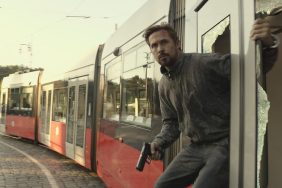
That’s about the only discernable fact you’re going to gleam from reading this, as it was one of the more beguiling set visits I’ve ever been on in six years of doing this, and that’s saying something.
It was such an unusual set visit, with no formal interviews to be had, that for the first time I felt like I had to watch the completed film itself in order to properly contextualize everything. Having seen the film, much of what was seen being shot that day makes more sense, although much of it will have to remain unexplained so that first-time viewers can enjoy the kaleidoscopic pleasures of suspense within this slowly-peeled onion of a thriller.
Pulling up to the stately manor that serves as the Stoker household, the tone of Alfred Hitchcock-meets-Edward Gorey was immediately recognizable. There’s not a lot of southern-fried Gone With The Wind-types to be found in the film, the backwoods setting merely lending it a more isolated, gothic feel.
One of the art decorators gives us a tour of the set, which feels very throwback despite the modern setting, with old clock radios and teardrop-shaped hammock chairs swinging from the trees outside. Each room seems dominated by a single color, whether it’s the pastel greens of the kitchen, the deep reds of Nicole Kidman’s bedroom, the stark/pure whites of Mia Wasikowska’s bedroom (with boxes of shoes scattered about), or the dark wood paneling of Dermot Mulroney’s drawing room, complete with a taxidermy-lovers bonanza of stuffed animals. There’s a piano in the living room, which plays host to a crucial scene where a composition written specifically for the film by Philip Glass will be played.
Of course none of this takes into account the personality of the film’s pivotal figure, Uncle Charlie, as played with devilish relish by Matthew Goode. Park makes no secret that this character is up to no good right from our first glimpse of him standing on a hill ominously overlooking his brother Richard’s (Mulroney) funeral, wearing sunglasses and a creepily neutral gaze. Just how messed up this guy is will be the real journey Wasikowska’s India goes on.
Even the title, Stoker, evokes the author of Dracula, but beyond the subtly supernatural (and sexually-charged) connection between dark uncle and “innocent” niece, that is only another facet to the screenplay by actor Wentworth Miller. The story goes that the Prison Break star sent the script out under the penname Ted Foulke so it would not be judged based on his name as an actor. The ruse worked, and now the opening titles declare proudly “Written by Wentworth Miller.”

Once outside we are greeted by the charming Wasikowska, fresh off her box office triumph in Tim Burton’s Alice in Wonderland. With her hair now straight and jet-black, she looks like Burton’s ideal prom date. There’s no real time to drill her, but she does show us a fake blister make-up artists have applied to her foot for a scene where she pops it on camera. Luckily she doesn’t have to take another 45-minutes in the make-up chair, as the shot goes off without a hitch.
The crew then switches gears to a flashback sequence featuring Tyler von Tagen and Thomas A. Covert as young versions of Mulroney and Goode’s characters. The action takes place on an old-school playground on the property, where the camera expertly cranes up and around as Richard finds Charlie making a dirt angel in the sand. In the film we also see Wasikowska making a similar motion on her bed, thus emphasizing India’s psychic connection with Uncle Charlie.
Between set-ups a translator introduces us to “Director Park,” a deceptively boyish-looking man for someone pushing 50, and his black trenchcoat makes him look very out of place for Tennessee, but just about perfect for whoever made this gothic horror flick. Unfortunately Park speaks hardly a lick of English, and after a very brief intro the director of Oldboy and Sympathy for Lady Vengeance goes off to continue making another masterpiece. Despite the disappointment of not getting to do a formal interview, this was a delight nonetheless, as Park is the only director I’ve ever seen work who I consider a flat-out genius.
The next set-up is perhaps the most contentious of the day, requiring upwards of 17-takes. It sounds rather simple: Young Richard is mowing the lawn, then sees something that catches his eye. Distressed, he runs away towards the playground, leaving the mower to scoot away across the green grass. Some of the takes are hampered by technical problems involving the mower, while others show a clear language barrier between Park, his translator, and the boy. When the final take is captured, it is clear from what we see in video village that everything Park has been working towards has come together in perfect harmony of a slow zoom-out.
In the final film this scene is presented in more of a fractured form, but that melds well with the overall style, which plays with the audience by showing certain sequences out of order, backwards, or sometimes in two totally different ways. This puts us in the mindset of India, a confused girl living a VERY interior existence in every sense of the word, not aided at all by her mother, played by Kidman.

Overall, the final cut of Stoker making its way into theaters this weekend is psychological horror in a post-De Palma vein, and far more complex than your average Southern Gothic yarn. The supernatural elements are so subtle you could argue they don’t exist at all, but there are awesome revelations and powerful performances on the nature of evil, and there is even a spider that crawls into someone’s vagina. If that last line didn’t sell you I don’t know what will
Stay up to date with the latest horror news by “liking” Shock Till You Drop’s Facebook page and following us on Twitter!









